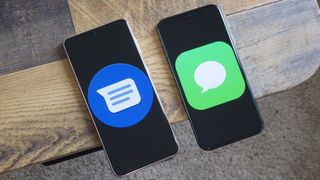Apple recently announced that it will add support for RCS (Rich Communication Services) messaging to iPhones starting in late 2023. This new messaging standard promises to significantly improve the texting experience between iPhones and Android phones.
What is RCS Messaging?
RCS is a next-generation messaging protocol that is positioned to replace SMS and MMS. It offers features like read receipts, typing indicators, high-resolution photo/video sharing, audio messages, group chats, and more. RCS works over mobile data or WiFi, with SMS/MMS as a fallback.
RCS is not a proprietary messaging app like WhatsApp. Rather, it is an open standard that allows mobile carriers and device makers to build advanced messaging functionality directly into the default texting apps on phones. For iPhone users, this means RCS capabilities would be added to the existing Messages app.
Why Hasn’t Apple Adopted RCS Yet?
Apple has resisted supporting RCS even as Android phones have widely adopted it in recent years. This has led to a poor and outdated texting experience when iPhone users message Android users and vice versa.
The reason Apple held out for so long likely comes down to two factors:
- Slow carrier adoption – Early RCS rollouts were fragmented across carriers, giving Apple little incentive to add support.
- Competition with iMessage – RCS could undermine iMessage by offering similar capabilities to Android users.
RCS vs. iMessage
 iMessage will continue to exist even after Apple adopts RCS. In fact, Apple says iMessage will remain the best and most secure messaging experience between Apple devices.
iMessage will continue to exist even after Apple adopts RCS. In fact, Apple says iMessage will remain the best and most secure messaging experience between Apple devices.
However, RCS adoption does mean iPhone users will get a much better texting experience when messaging non-Apple devices. Features like high-quality media sharing, read receipts, and group chats will work cross-platform instead of breaking.
Apple has not yet provided specifics on how it will integrate RCS into iOS. It’s unclear if Android messages will remain green speech bubbles distinct from blue iMessage bubbles.
Why Is Apple Now Supporting RCS?
After years of resisting, Apple’s sudden embrace of RCS likely comes as a result of regulatory pressure in Europe.
The EU’s new Digital Markets Act (DMA) aims to curb anti-competitive behavior by “gatekeeper” tech companies like Apple. The DMA guidelines prohibit gatekeepers from limiting interoperability with third-party products and services.
In November 2022, Google filed a formal DMA complaint alleging that Apple’s lack of RCS support excludes Android users and violates the Act. Apple announced its plans to adopt RCS just before the deadline for companies to contest their DMA gatekeeper designation.
Apple is expected to challenge its DMA gatekeeper status related to iMessage and the App Store. Supporting RCS messaging could be Apple’s attempt to get out in front of EU regulators.
What RCS Means for Users
For both iPhone and Android users, Apple’s support for RCS messaging will finally unlock a modern texting experience between the two platforms. Features like:
 High-quality photo/video sharing
High-quality photo/video sharing- Read receipts
- Typing indicators
- Audio messages
- Group chats
This will eliminate frustrating issues like messages getting stuck as green text bubbles instead of MMS, poor quality shared media, and group chats breaking between platforms.
Apple adding RCS also validates it as the global standard for messaging, as all major mobile OSes now support it. Over time, this could marginalize SMS and make RCS the default messaging protocol.
However, Apple says it also plans to work on adding end-to-end encryption to RCS in the future. This could eventually make RCS messaging as secure as iMessage, eliminating one of Apple’s competitive advantages.
The messaging experience between iPhone and Android users still has room for improvement. But Apple embracing RCS is a major step toward modern cross-platform texting and more seamless iPhone and Android interoperability.











